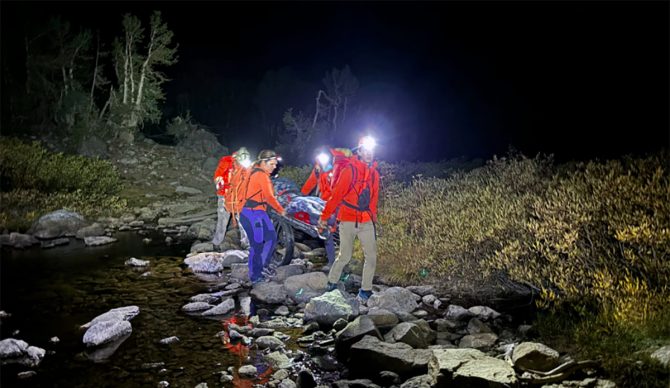
It was a crazy 21 hours on the trail to Mt. Whitney. Photo: Inyo County Search and Rescue
Standing atop the highest peak in the “Lower 48” is a badge of honor hikers love to pad their resume with. The 22-mile round-trip up California’s Mt. Whitney ascends more than 6,000 feet to the summit. The trek is no small feat and a recent ill-prepared expedition served as a reminder of just about everything you should not do when taking on this Sierra Nevada gem.
Inyo County Search and Rescue posted about its November 2 mission to rescue two distressed hikers. The details were out there, to say the least.
Two hikers commenced the trek from the Mt. Whitney trailhead in the dark at 6 p.m. They planned to spend the night at Lone Pine Lake – a three-mile hike and 1,700-foot elevation gain – and summit Whitney (14,505 feet) the following day. On paper, it seems okay, but their preparation was….let’s just call it unsound.
The hikers went on a shopping spree, purchasing 150 pounds of new gear. From the photos posted, it appears they had a large backpack and several smaller packs, a ginormous tent, a small food cooler, and a large lamp, among other items. If that wasn’t already a debilitating amount of weight, they also carried five gallons of water and no filtration device. Between the gear and the water, there were nearly 100 pounds of weight for each hiker to haul.
They didn’t get far. Nine hours later, at 3 a.m., they’d ascended 2.7 miles up the trail and decided they were too exhausted to continue. They camped, leaving their shoes outside the tent, which filled up with snow from an overnight dusting. One hiker complained of blisters and a headache, and another (it’s unclear if it was the same hiker) reported that she had a “mass” in her brain sensitive to barometric pressure.
Why was someone who had known altitude sensitivities hiking the highest point in the continental United States…? Reddit users were similarly baffled. But I digress.
The following day, realizing the pickle they were in, the hikers used their iPhone satellite SOS capabilities to call for help. Search and rescue reached them by 1:40 p.m. After allotting time to rest and dry their shoes (and enlisting the aid of a kind samaritan to carry their gear), they were back at the trailhead by 3:15 p.m. That’s a whacky 21 hours on the mountain.
It was quite clear that this group had little-to-no backpacking experience and went straight for the dinner platter, biting off one of the meatiest hikes in the country. If you don’t happen to backpack, and it isn’t obvious what mistakes were made, allow me to riff off a few.
When I backpack, 40 pounds is a heavy pack. For a short one- or two-night trip, with plentiful water sources, my pack weight would hopefully be half that. A hundred pounds is like schlepping a small human up the trail. It’s an impossible task except for maybe the most extreme athletes.
I’ve admittedly overpacked water in the past, but five gallons – nearly 42 pounds of weight – is absurd. Just finding the space would be a challenge. Backpackers carry simple, yet effective, water filtration tools. You don’t need to carry more than a few liters at a time – filter as you go.
I consider myself a budget backpacker. A nice trip doesn’t cost much, but you do need relatively light, compact gear. For example, today’s backpacking tents are way smaller and lighter than the one they purchased. A small headlamp or flashlight would do instead of the bulky porch lamp they packed. And the huge tarp? I presume it was a footprint for the tent. Probably not necessary.
This should go without saying, but leaving shoes outside the tent’s rainfly to get wet overnight? Plus, rescuers noted they didn’t have a bear canister (a food-storage container required to avoid bear encounters in the Sierra Nevada) or check the weather beforehand.
They’re lucky they didn’t find themselves in worse trouble. On the bright side, rescuers pointed out a few things they did to avoid a more perilous situation. They stopped when they realized they were in trouble instead of pushing further up the mountain, and they stayed together. Knowing that the newer iPhone doubles as a satellite emergency communication tool was also key.
Not to trash these adventurers. I carried some funny items in my early backpacking days, too. I’ve refined my pack over the years and learned my limits. But this Mt. Whitney example is extreme. Thankfully, they have a “next time.” And their trial by fire probably gained them a lifetime of knowledge in one outing.

